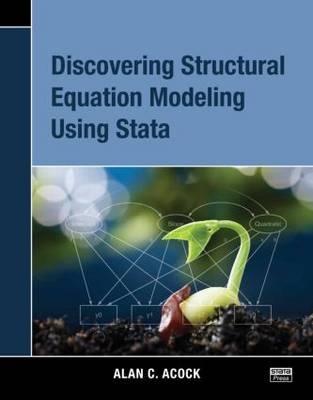
Discovering Structural Equation Modeling Using Stata
Stata Press (Verlag)
978-1-59718-133-4 (ISBN)
- Titel ist leider vergriffen;
keine Neuauflage - Artikel merken
A particularly exciting feature of Stata is the SEM Builder. This graphic interface for structural equation modeling allows you to draw publication-quality path diagrams and fit the models without writing any programming code. When you fit a model with the SEM Builder, Stata automatically generates the complete code that you can save for future use. Use of this unique tool is extensively covered in an appendix, and brief examples appear throughout the text.
Requiring minimal background in multiple regression, this practical reference is designed primarily for those new to structural equation modeling. Some experience with Stata would be helpful but is not essential. Readers already familiar with structural equation modeling will also find the book’s State code useful.
Alan Acock is a sociologist and a University Distinguished Professor in the School of Social and Behavioral Health Sciences at Oregon State University. He has published more than 130 articles in leading social and behavioral science journals. He is also the author of A Gentle Introduction to Stata.
Introduction to Confirmatory Factor Analysis
Introduction
The "do not even think about it" approach
The principal component factor analysis approach
Alpha reliability for our nine-item scale
Generating a factor score rather than a mean or summative score
What can CFA add?
Fitting a CFA model
Interpreting and presenting CFA results
Assessing goodness of fit
A two-factor model
Parceling
Extensions and what is next
Using Structural Equation Modeling for Path Models
Introduction
Path model terminology
A substantive example of a path model
Estimating a model with correlated residuals
Auxiliary variables
Testing equality of coefficients
A cross-lagged panel design
Moderation
Nonrecursive models
Structural Equation Modeling
Introduction
The classic example of a structural equation model
Equality constraints
Programming constraints
Structural model with formative indicators
Latent Growth Curves
Discovering growth curves
A simple growth curve model
Identifying a growth curve model
An example of a linear latent growth curve
How can we add time-invariant covariates to our model?
Explaining the random effects—time-varying covariates
Constraining variances of error terms to be equal (optional)
Group Comparisons
Interaction as a traditional approach to multiple-group comparisons
The range of applications of Stata’s multiple-group comparisons with sem
A measurement model application
Multiple-group path analysis
Multiple-group comparisons of structural equation models
Epilogue–What Now?
Appendix A: The graphical user interface
Appendix B: Entering data from summary statistics
References
Author Index
Subject Index
Exercises appear at the end of each chapter.
| Erscheint lt. Verlag | 16.5.2013 |
|---|---|
| Verlagsort | College Station |
| Sprache | englisch |
| Gewicht | 658 g |
| Themenwelt | Geisteswissenschaften ► Psychologie |
| Mathematik / Informatik ► Mathematik ► Angewandte Mathematik | |
| Mathematik / Informatik ► Mathematik ► Computerprogramme / Computeralgebra | |
| ISBN-10 | 1-59718-133-1 / 1597181331 |
| ISBN-13 | 978-1-59718-133-4 / 9781597181334 |
| Zustand | Neuware |
| Haben Sie eine Frage zum Produkt? |
aus dem Bereich


